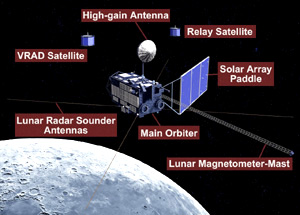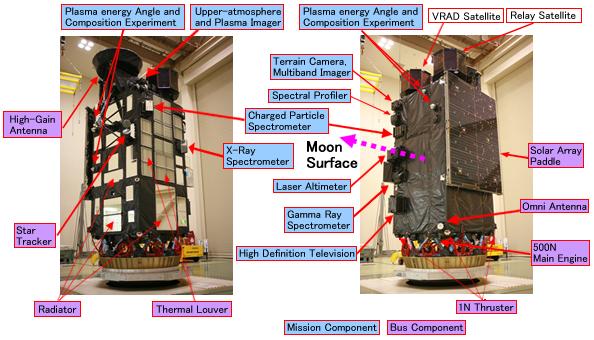Overview of KAGUYA Project

The Japan Aerospace Exploration Agency(JAXA) launched "KAGUYA (SELENE)" by the H-IIA Launch Vehicle at 10:31:01 a.m. on September 14, 2007 (JST) from Tanegashima Space Center.
The topic for this exploration is "How was the Moon formed and how has it changed?" The scientific theme is called "the Moon's origin and evolution." The major objectives of the KAGUYA mission are to obtain scientific data and investigate the scientific theme.
*) The left picture is the mission mark of KAGUYA.
As for details, please view here.
Main Characteristics of KAGUYA | Mission
Main Characteristics of KAGUYA

Main Orbiter
| Mass: | 3 tons |
|---|---|
| (at launch, including two small satellites) | |
| Size: | 2.1m x 2.1m x 4.8m |
| Attitude Control: | Three-axis stabilized |
| Power: | 3.5 kW (Max.) |
| Mission period: | 1 year |
| Mission Orbit: | Circular orbit, Altitude 100km Inclination 90 degree |
Small satellites
| Mass: | 50 kg |
|---|---|
| Size: | 1.0 x 1.0 x 0.65 m |
| Attitude Control: | Spin-stabilized |
| Power: | 70 W |
| Orbit: (Initial Orbit) |
"OKINA" [Relay Satellite] Elliptical orbit (100km x 2,400km), Inclination 90 degrees "OUNA" [VRAD Satellite] Elliptical orbit (100km x 800km), Inclination 90 degrees |
Mission

Mission Instruments
| Mission Group | Mission Instruments | Mission Overview |
|---|---|---|
| Elemental distribution |
X-ray Spectrometer (XRS) |
The surface elemental composition (Al, Si, Mg, Fe, etc.) is determined through X-ray fluorescence spectrometry by irradiation of solar X-rays. |
| Gamma Ray Spectrometer (GRS) |
The abundance of key elements (U, Th, K, H, etc.) is determined by measuring energy spectra of gamma-rays from the lunar surface with high energy resolution. | |
| Mineral distribution |
Multi band Imager (MI) |
The mineral distribution is obtained by taking the visible and near infrared images of the Moon's surface in nine wavelength bands. |
| Spectral Profiler (SP) |
The mineral composition of the Moon's surface is obtained by measuring the continuous visible and near infrared spectrum. | |
| Surface and sub-surface structure |
Terrain Camera (TC) |
High-resolution geographical features are acquired by the stereo cameras. |
| Lunar Radar Sounder (LRS) |
The subsurface stratification and tectonic features in the shallow part of the lunar crust (a few km) by high-power RF pulses. | |
| Laser Altimeter (LALT) |
To make the lunar topography model, the altitude is precisely measured using high-power laser pulses. | |
| Environment | Lunar Magnetometer (LMAG) |
The magnetization structure on the Moon is acquired by measuring the lunar and the surrounding magnetic field. |
| Charged Particle Spectrometer (CPS) |
Alpha rays from the Moon's surface and the abundance of cosmic ray particles are measured. | |
| Plasma energy Angle and Composition Experiment (PACE) |
The three dimensional distribution of the low-energy electrons and mass-discriminated low-energy ions around the Moon are measured. | |
| Radio science (RS) |
The Moon's ionosphere is detected by measuring the small deviation of the phase of RF signals from the VRAD satellite. | |
| Upper-atmosphere and Plasma Imager (UPI) |
Images of the magnetosphere and the ionosphere around the Earth are taken from the Moon to study the behavior of the plasma. | |
| Gravitational field distribution |
Four way Doppler measurements by Relay satellite and Main Orbiter transponder (RSAT) |
The local gravity field of the far-side of the Moon is observed by measuring the disturbance of the orbit of the Main Orbiter using Doppler measurement. |
| Differential VLBI Radio Source (VRAD) |
The accurate gravity field data of the Moon are obtained by measuring the orbits of "OKINA" [Relay] and "OUNA" [VRAD] satellites using differential VLBI observation of S and X band radio waves.(VIBI: Very Long Baseline Interferometer) | |
| High definition Image |
High Definition Television (HDTV) |
Taking pictures and movies of the Earth and the Moon with high-definition television cameras. |